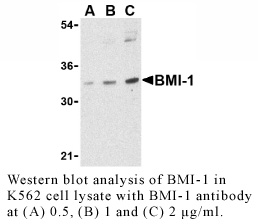Anti-Human BMI-1 (Intermediate Domain)
Data
- -
- -
Antibody DetailsProduct DetailsReactive Species Human Host Species Rabbit Immunogen PN:B501 Product Concentration 0.5 mg/ml Formulation This polyclonal antibody is formulated in phosphate buffered saline (PBS) pH 7.4 containing 0.02% sodium azide as a preservative. Storage and Handling This polyclonal antibody is stable for at least one week when stored at 2-8°C. For long term storage, aliquot in working volumes without diluting and store at –20°C in a manual defrost freezer. Avoid Repeated Freeze Thaw Cycles. Country of Origin USA Shipping Next Day Ambient RRIDAB_2828223 Each investigator should determine their own optimal working dilution for specific applications. See directions on lot specific datasheets, as information may periodically change. DescriptionSpecificity Rabbit Anti-Human BMI-1 recognizes an epitope in the intermediate domain of human, mouse and rat BMI-1. This polyclonal antibody was purified using affinity chromatography. Background The transcriptional repressor BMI-1 was first identified as a proto-oncogene frequently activated by Moloney murine leukemia proviral insertions in mice and cooperating with c-myc in the generation of mouse lymphomas. BMI-1 is involved in segment specification, cell growth and maintenance, transcriptional regulation, and chromatin modification. A major target of BMI-1 is the ink4a locus which encodes tumor suppressor proteins p16 and p19Arf, which are important in tumor progression and thought to be critical in cell proliferation and senescence.2 Recent studies have also shown that BMI-1 is required for the maintenance of adult normal and leukemic stem cells,3 suggesting that BMI-1 could an attractive therapeutic target for stem cell proliferation and renewal as well as for anti-cancer strategies. Antigen DetailsPubMed References & Citations1. Alkema, MJ. et al. (1993) Hum. Mol. Genet. 2:1597 2. Jacobs, J J. et al. (1999) Nature 397:164 3. Lessard, J. et al. (2003) Nature 255 Technical ProtocolsCertificate of Analysis |
Related Products
- -
- -
Prod No. | Description |
|---|---|
B481 | |
B501 |
 Products are for research use only. Not for use in diagnostic or therapeutic procedures.
Products are for research use only. Not for use in diagnostic or therapeutic procedures.



